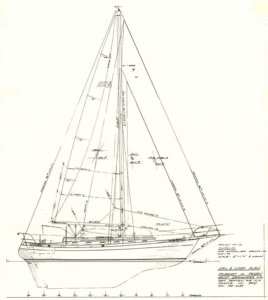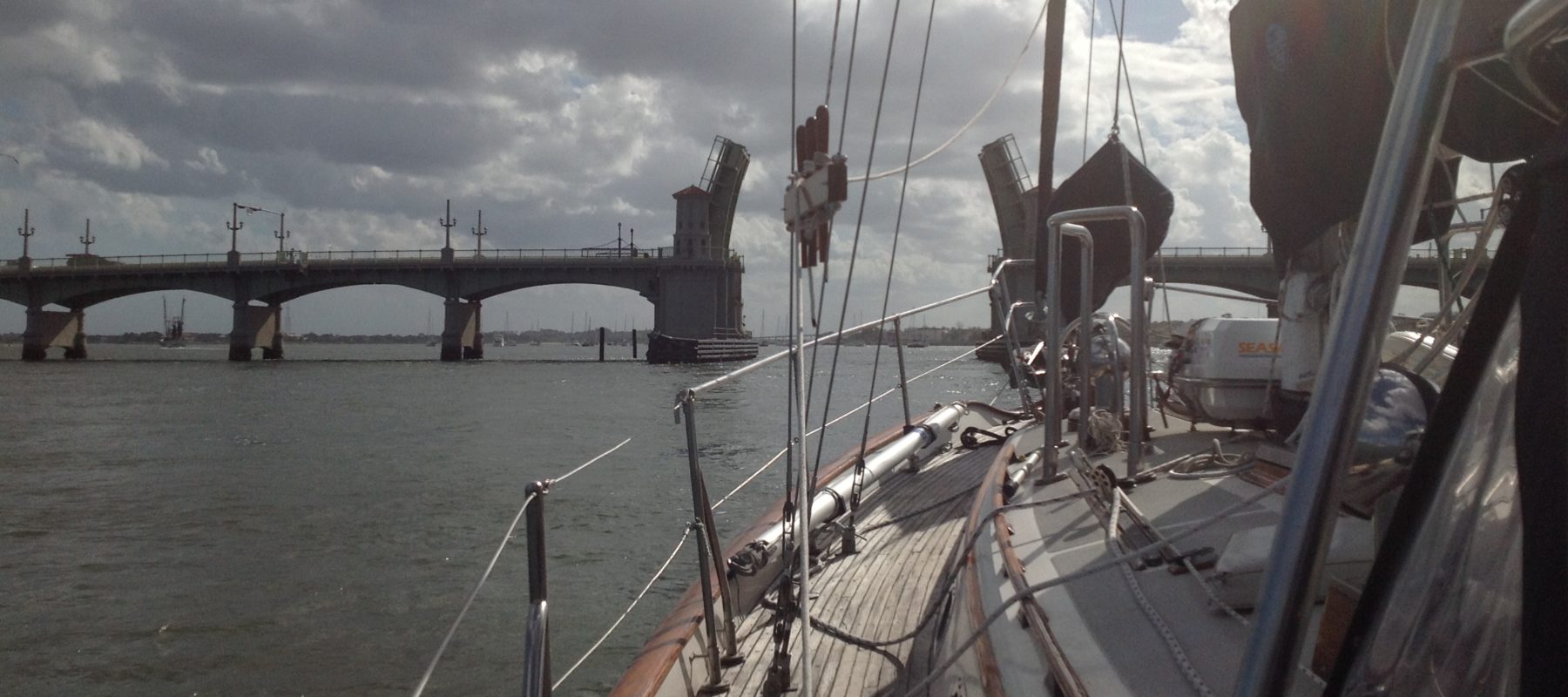About Sophia
Sophia is a Baba 40 built in Taiwan and delivered to Annapolis in 1984. The Baba 40, also known as the Panda 40 and later the Tashiba 40, is the third of the Baba lineup of boats involving developer Bob Berg, designer Bob Perry, and the Ta Shing boatyard. One can arguably consider the Baba 40 a full keel reincarnation of the Valiant 40, the boat that put the word “performance” next to “cruiser”. Baba 40 inherits a good turn of speed – owners even trumpet around-the-buoys racing victories in these serious blue water cruisers. They are beautifully balanced with a wonderful feel at the helm, and what’s more, they have some of the best interiors to be seen in production cruising yachts.

Specifications
Documentation Number 684336
Hull Identification Number – TSQ40129L484
MMSI – 338135301
LOA: 39′ 11″ (excluding bowsprit)
LWL: 34′ 6″
Beam: 12′ 10″
Draft: 6″ 0″
Displacement: 29,000 lbs.
Ballast: 10,000 lbs.
Sail Area: 865 sq. ft.
Bridge Clearance: 55 feet
Headroom: 6′ 5″
Engine: Yanmar 4JH3E diesel
Fuel Capacity: 96 US. gallons in two 42 gallon fuel tanks and one 12 gallon fuel tank
Water Capacity: 135 US. Gal. (85 port tank, 50 starboard tank)
Sails:
140% genoa (2103 Rolly-Tasker) on a Schaefer 3100 furling system
Staysail (2015 Roll-Tasker) on s Schaefer 3100 furling system
North Sails full-battened mainsail with Antal sliders (1999) with sheet, halyard, topping lift, and 2 reefing lines led to the cockpit
Storm Trysail (2005)
Storm Jib (2005)
Galley
SeaFrost Refrigerator
Seafrost Freezer (new in 2017)
Hot Water Heater
Microwave
Mariner Regal three burner stove with oven
2 20 pound propane tanks
Gas BBQ grill
Deck
9 ft 10 inch Defender 300 Hypalon RIB dinghy
Dinghy Davits
Mercury 4HP Outboard
Anchors
- 55 lb Delta with 200 foot of chain and 100 foot nylon rode
- 45 lb Bruce with 50 foot of chain and 200 foot of nylon rode
- 35 lb Fortress Danforth with 20 foot of chain and 300 foot of nylon rode
Simpson Lawrence SL555 double action manual anchor windlass
Electronics:
Garmin 942XS chartplotter (new 2019)
Garmin 741 Chartplotter
Garmin 441 Chartplotter
Garmin through-hull depth sounder
Garmin AIS 600
Standard Horizon Matrix GX2150 VHF Radio with AIS and Remote Access Microphone
Standard Horizon Spectrum VHF Radio
Raymarine ST60 wind, speed, and depth instruments with 2 Multi Repeaters
Raymarine EV400 Sail Pilot autopilot
Garmin Radar (new 2019)
SEA2250 HF Radio attached to backstay antenna
Sony Bluetooth Audio System with CD, IPOD, and XM/Sirius Satellite Radio (Garmin)
Electrical
NextGen 4kw Generator (new 2020) with Promariner battery charger
AirBreeze Wind Generator
MarineAir 1600 BTU reverse cycle air conditioner/heater (new 2019)
Service Battery bank of 630 amp hours (1 – 8D and 3 #31 AGM)
Group 31 starter battery
Freedom Series 25 charger/inverter with Heart Interface
5 GPM Fresh Water Pump
Head
Full shower with hot and cold water
Electrosan Marine Sanitation Device
Safety
ACR Global Fix V4 EPIRB
4 inflatable liftjackets (two with harness) and two jacklines
2 AIS MOB transponders
Man overboard (MOB) pole with strobe light
Revere 6 person SeaSava Offshore liferaft located in on deck canister
History
The story of the Baba 40 really starts with the Baba 30 which brought together a winning combination of talents – developer Bob Berg, designer Bob Perry, and what was then a little known Taiwanese boatyard called Shing Sheng. Through the success of the little Baba 30 and the Baba 35, Shing Sheng started on the road to become a force in the boatbuilding world. By 1979 they had changed their name to Ta Shing and had moved to a new purpose built factory. It was in this year that Berg commissioned Perry to design a new 40-foot model to fill out the line.
Perry was not happy with merely evolving his earlier Baba 35 design, which in itself was a stretched version of the 30. Instead, in search of more boat speed, Perry dusted off the lines of his famous Valiant 40 with its radical fin keel and separate skeg-hung rudder had defined the “performance cruiser” category only five years earlier. From the Valiant 40 hull form he derived an all-new full keel design which was to be the Baba 40. It proved to be a huge step forward over earlier Babas with Perry describing the Baba 40 having an entirely different stability personality. It was stiffer initially, beautifully balanced and much faster.
Tim Ellis who oversaw construction fondly remembers the symbiotic partnering of Berg’s development and management, Perry’s design, and Ta Shing’s undisputed capabilities as builder. He recalls the exacting attention fostered by Berg.
“They produced a design of sublime artistry. I think it is no exaggeration to suggest that Bob Berg made at least thirty or more visits to Taiwan during the years Baba designs were under development and construction, and he and I would sit on each yacht for hours, days and more to fine tune shapes, appearances, major and minor details, and resolve the niggling issues that plagued others less well traveled. My job was to take Bob’s advice and adjustments and translate them into action. My list of items might run into the hundreds during each visit, and many, many more on a hull number one. In pursuit of his ideal, Bob left no room for equivocation, and a lesser builder would have baulked.” – Tim Ellis
The Baba 40 was introduced to the public in 1980. In 1983, when Berg left his association with the Flying Dutchman dealership who owned the Baba trademark, he marketed the boat as the Panda 40. This name did not last long and by 1984, with Ta Shing now a contender in Taiwanese boat-building, marketed the boat by themselves using the name Tashiba 40. It’s been speculated this was a play on the words names “Ta Shing” and “Baba”.
Production ended in 1996 with a total of 115 boats being built, although hull numbers can be found that run up to #182, there is a gap between #33 and #101.
Ta Shing eventually formed an exclusive relationship with the Californian based company PAEI who had Al Mason as their in-house designer. Sadly, years later when PAEI shifted focus to power boats, many of Ta Shing’s molds including the Baba 40 were cut up.
Configuration
The lines of the Baba 40 follows its ancestry back to traditional Scandinavian double-enders. Under the waterline is a full keel with a cutaway forefoot and as with many of the Perry full keel designs, the keel meets the bilge of the hull without the traditional “wine glass” section blend. Both features reduce wetted area. The hull shape is relatively beamy offering good interior volume.
Interior
Belowdecks the quality of workmanship is superb, many Taiwanese man-hours were used in detailing the interiors with the close guidance of Berg who was known for his ability to squeeze function into every square inch of a boat. Perry also considered it one of his best, noting that it feels “right” with near perfect detailing and a layout with no apparent compromise.
On the starboard quarter, there’s a cabin with a double seagoing quarter-berth. To port there’s a well laid out U-shaped galley. In the saloon, a two-settee berth layout with pilot berth to port was offered as an option to provide extra sea-going berths. In the forward cabin, there’s a double berth offset to port. Headroom is a generous 6′ 5″.
Construction
The Baba 40 hull is solidly built in hand-laid GRP, with hull thickness growing from 0.41″ thick at the topsides to 0.57″ at the waterline, and 0.90″ at the keel. The deck is cored with end-grained balsa, as well as high density closed-cell foam in the deck and cabin trunk. The ballast is cast iron and is encapsulated in GRP, though one boat at least was built with lead ballast.
Under Sail
The boat has a wonderful feel at the helm and is a fun to sail, especially as the breeze picks up. Some owners have even raced their Baba 40s against modern fin keel competitors successfully. As a testament to the boat’s speed, Michael and Elizabeth Kramer in S.V. Cambria covered 396 miles in a 46 hour passage down the Sea of Cortez broad reaching in 35 knots of wind; an impressive average of 8.6 knots.
Owners often describe their Baba’s to have a feel of solidity. In heavy weather conditions the Baba 40 has the capacity to keep sailing when many other boats are heaving-to. Of note is Jeff Hartjoy’s solo passage from Peru to Buenos Aires via Cape Horn in 2009 where he experienced an immense amount of bad weather. On that passage he reported a lot of breakages but commented about the soundness of his boat.
Year Introduced: 1980
Year Ended: 1996
Designer: Robert H. Perry
Developer: Bob Berg (Quicksilver Corp.)
Builder: Ta Shing, Taiwan
